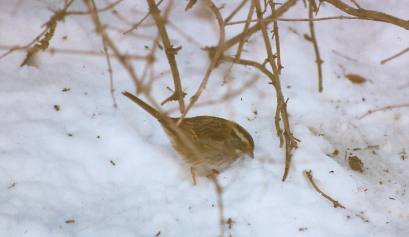The City Naturalist
White Throated Sparrow
Article and Photos by Leslie Day
 WHITE THROATED SPARROW:
Zonotrichia albicollis: Genus name: latin from zone
or band and thrix: hair, referring to the striped head
feathers or crown of this small bird; and species name from
Latin: white and colum: neck.
WHITE THROATED SPARROW:
Zonotrichia albicollis: Genus name: latin from zone
or band and thrix: hair, referring to the striped head
feathers or crown of this small bird; and species name from
Latin: white and colum: neck.
DESCRIPTION: The White throated sparrow is a small bird with a rusty brown-striped back, gray breast, two white wing bars, black and white stripes on its crown, yellow spots between its eye and bill and a conspicuous white throat. It is between 6 and 7 inches long, with a wingspan of 9 inches. The males and females look similar, but immatures are duller in color.
VOICE: Haunting, clear, sweet and wavering whistled notes, often translated as "Old Sam Peabody, Peabody, Peabody". Their other call is "tseet," a contact note when the sparrows cannot see each other. Both the males and females sing.
LOCALLY: White throated sparrows migrate south in small flocks and arrive in Riverside Park anywhere from mid September to mid October, depending on the weather. Due to the mild autumn of 1996, they arrived this year in the last week of October.
FEEDING HABITS: White throated sparrows feed on tree seeds such as Sweetgum, and wildflower and weed seeds so common here in Riverside Park, such as Amaranth and Chickweed. They scratch noisily, throwing aside the leaf litter in search of ants, beetles, flies and other insects. In early spring, before they migrate back north, they enjoy the leaf buds of our oaks, maples and crabapple trees.
RANGE: White throated sparrows winter from Massachusetts, Connecticut, and Central New York, south to northern Florida. They summers from Newfoundland south to Central New York.
NESTS: The females build the nests in wet as well as dry thickets, often on the ground at the edge of clearings, concealed under a bush or in roots of upturned stumps. They build their nests with coarse grasses, twigs, pine needles and line them with grass, rootlets and deer hair.
INCUBATION: The female sits on the nest for 12-14 days. The young fledge or leave the nest one to two weeks after hatching and fly around for a couple of days after leaving the nest. Usually one brood per year is raised.
LIFESPAN: 9 year old banded white-throats have been recorded.
About Leslie Day | For Further Information
Copyright © 1996-2012 The 79th Street Boat Basin Flora and Fauna Society.
